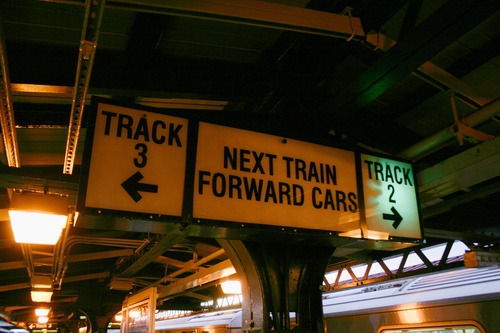



Wakefield-241 Street is the terminus of the 2 train and White Plains Road Line. It is the only stop on the 2 train where the 2 train's track is not shared with the 3 train or the 5 train. It is the most northern subway station in the New York City, located in the Bronx Neighborhood of Wakefield that was part of Westchester County until 1895 as an incorporated village (created in 1889) in the town of Eastchester. It was originally annexed by New York County before the Bronx became a separate borough in 1898 with the consolidation of Greater New York (today’s New York City) and became part of the Bronx in its own county in 1914.
The terminus station has two tracks and three platforms. The island platform is the only one used by passengers, the side platforms are used by employees with a bunch of employee rooms built on the southern side platform. This 3 track, 2 platform layout is similar to all the other Bronx terminuses built by the IRT (242 Street-Van Courtland Park, Woodlawn, and Pelham Bay Park, and 180 Street-Bronx Park before it was abandoned and demolished) but no other stations on the subway system (including New Lots Avenue, the other elevated IRT terminal station) have this unique design.
The platforms are canopied for their entire lengths except for a car length at their southern ends. The southern ends of the original canopy are directly under an employee building — lunchrooms and locker rooms for T/Os and C/Rs at the southern end of the platforms — with a tiny, exposed portion of the platform beyond their southern ends.
The station was renovated towards the end of the White Plains Road line renovations in 2010. The side platforms received the conventional green and cream windscreens with some mesh walled windows out to the surrounding area, tactile warning strips were also added. The island platform (that is actually for all passenger service) got small windscreens holding up platform signs which is the station's Arts For Transit installation. The side platforms previously had the corrugated windscreens of nearly all elevated stations.
To leave the platform, unlike at other 3 platform terminus stations, there is a single staircase, one car from the northern end of the platform. It, along with a single staircase down from the unused side platforms, leads down to a station house under the tracks. The staircases up to the side platforms simply have No Entry signs above them but no sort of other barriers. The fact they are fully intact without any buildings built upon them means they could be used as Exit Platforms, particularly when a train is going out of service to then be fully fumigated of passengers to head to the train yard. This would remove the issue of passengers getting on the one train in the station expecting it to be in service when its going out of service and heading to the train yard. There are also a few ancilary buildings behind the bumper blocks but there is no need for passengers to walk by them to get on trains.
This station house has a very similar design to the conventional local stations farther down the line. The walls are different shades of green with windows looking out on the sides of the station (all directions from the station, except due south lead into Westchester County). Turnstiles are directly in front of the one staircase down from the open island platform, with one High Exit turnstile. From 3 of the 4 corners of the station house streetstairs lead down to the NW, SE, and SW corners of 241 Street and White Plains Road.
1 & 2: February 21, 2005; 3: January 13, 2012; 4-14: April 2, 2013;
Arts For Transit at Wakefield-241 St
Permanent Residents and Visitors, 2010, Faceted Glass
By Alfredo Ceibal




